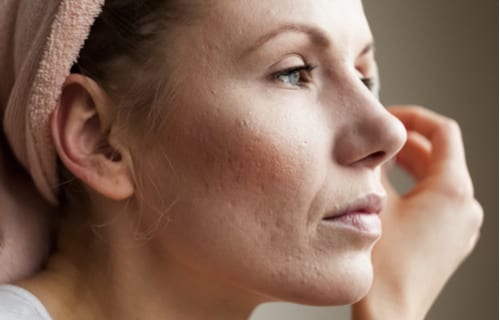
Facial scarring is a common, and commonly misunderstood, problem faced by many people. To help clarify treatment options, we must create two categories of scars.
Treatment For A Single Scar
The first category is a single dominant scar. This can be the result of a laceration from a car accident, knife injury, or other traumatic event. Oftentimes folks with this type of scar are bothered by people’s attention being drawn to their cheek scar or forehead scar, instead of their eyes, which is the normal focal point. When lacerations are relatively fresh, the immature scar is red, raised, and very noticeable. Over approximately one year, the scar matures and becomes more pale, flat, and less noticeable. After this healing period, if a scar is still bothersome, then treatment can be considered. The primary treatment option for this type of scar is surgical. This surgery is designed to remove the existing scar and “irregularize” the area. People’s gaze is drawn to long, linear scars. Therefore irregularization is performed to convert the scar into more of a zig-zag pattern, which does not draw unnecessary attention. Specifically, the two methods of scar irregularization are called “W-plasty” and “geometric broken line closure”. This type of surgery can be performed in the office or the operating room under varying levels of anesthesia, from fully asleep to fully awake. Recovery time is approximately one week, and although the new scar would initially be noticeable, it would fade naturally with time resulting in a drastic improvement compared to the original scar.
Treatment For Multiple Facial Scars
The second category is multiple diffuse scarring. This is often the result of acne or chickenpox. Many times folks with this type of scarring are bothered by a diffusely poor skin quality, which may be worse over certain areas of the face such as the cheeks or forehead. Frequently people suffer this type of scarring in childhood or the teenage years, and then they seek treatment in young adulthood or middle age. By the time they seek treatment, there is no further “maturation” or natural healing that would occur. There are 2 main treatment options for this type of scarring. The first treatment option is performed in the office, and could be called low risk-low reward. This would entail a series of chemical peels and microneedling treatments. Each treatment would be separated in time by approximately 1 month, and 4-6 treatments would be recommended to see improvement. The second treatment option is performed in the operating room, and could be considered higher risk-higher reward. This would entail a procedure called “combined resurfacing”, which is the combination of a deep chemical peel, dermabrasion, and CO2 laser skin resurfacing. This very effective treatment has a noticeable recovery period of approximately one week for the skin to heal. This is followed by several weeks to months of noticeable skin redness that fades over time. Ultimately the skin will have a much improved texture and appearance. This procedure remains one of the best options for severe acne scarring, and patients are overwhelmingly happy with their new skin quality.
